A New Zero-Voltage Zero-Current Switching Converter with Minimum Duty Cycle Loss
Abstract
1. Introduction
2. Circuits and Operation Principles
2.1. Circuit Configuration
2.2. Normal Mode
2.3. Duty Cycle Enhanced Mode
3. Performance Analysis and Comparison
3.1. Duty Cycle Loss
3.2. Condition of Soft-Switching
3.2.1. ZVZCS of Q1 to Q4
3.2.2. ZVZCS of Auxiliary Switches
3.3. Comparison
3.3.1. Consideration
3.3.2. Performance Comparison
4. Experiments’ Results
5. Conclusions
- (1)
- The duty cycle loss can be reduced effectively, and the circuit can be optimized;
- (2)
- The primary switches can realize soft-switching over a wide load range and the additional power loss caused by the auxiliary circuit is low;
- (3)
- The ZVZCS operation has no power rating limitation;
- (4)
- The electrical stress of the components is much lower than that of the conventional ZVZCS PSFB converter.
Author Contributions
Funding
Data Availability Statement
Conflicts of Interest
References
- Dusmez, S.; Hasanzadeh, A.; Khaligh, A. Loss analysis of non-isolated bidirectional DC/DC converters for hybrid energy storage system in EVs. In Proceedings of the 2014 IEEE 23rd International Symposium on Industrial Electronics (ISIE), Istanbul, Turkey, 1–4 June 2014; pp. 543–549. [Google Scholar]
- Dusmez, S.; Khaligh, A. A Supervisory Power-Splitting Approach for a New Ultracapacitor–Battery Vehicle Deploying Two Propulsion Machines. IEEE Trans. Ind. Inform. 2014, 10, 1960–1971. [Google Scholar] [CrossRef]
- Khaligh, A. Realization of Parasitics in Stability of DC–DC Converters Loaded by Constant Power Loads in Advanced Multiconverter Automotive Systems. IEEE Trans. Ind. Electron. 2008, 55, 2295–2305. [Google Scholar] [CrossRef]
- Lee, D.-W.; Youn, H.-S.; Kim, J.-K. Development of Phase-Shift Full-Bridge Converter with Integrated Winding Planar Two-Transformer for LDC. IEEE Trans. Transp. Electrif. 2023, 9, 1215–1226. [Google Scholar] [CrossRef]
- Shen, J.; Hasanzadeh, A.; Khaligh, A. Optimal power split and sizing of hybrid energy storage system for electric vehicles. In Proceedings of the 2014 IEEE Transportation Electrification Conference and Expo (ITEC), Dearborn, MI, USA, 15–18 June 2014; pp. 1–6. [Google Scholar]
- Lyu, D.; Soeiro, T.B.; Bauer, P. Design and Implementation of a Reconfigurable Phase Shift Full-Bridge Converter for Wide Voltage Range EV Charging Application. IEEE Trans. Transp. Electrif. 2023, 9, 1200–1214. [Google Scholar] [CrossRef]
- Ochoa, D. Extension of the Injected-Absorbed-Current Method Applied to DC–DC Converters with Input Filter, Output Postfilter, and Feedforward Compensations. IEEE Trans. Transp. Electrif. 2022, 8, 856–874. [Google Scholar] [CrossRef]
- Zhao, L.; Li, H.; Wu, X.; Zhang, J. An Improved Phase-Shifted Full-Bridge Converter with Wide-Range ZVS and Reduced Filter Requirement. IEEE Trans. Ind. Electron. 2018, 65, 2167–2176. [Google Scholar] [CrossRef]
- Zhu, Y.; Guo, Z.; Geng, Q. An Improved Full-Bridge Converter with a Five-Diode Rectifier for High Efficiency in Wide Voltage Range. IEEE Trans. Power Electron. 2022, 37, 3178–3191. [Google Scholar] [CrossRef]
- Chen, W.; Ruan, X.; Zhang, R. A novel zero-voltage-switching PWM full bridge converter. IEEE Trans. Power Electron. 2008, 23, 793–801. [Google Scholar] [CrossRef]
- Chen, W.; Ruan, X.; Chen, Q.; Ge, J. Zero-voltage-switching PWM fullbridge converter employing auxiliary transformer to reset the clamping diode current. IEEE Trans. Power Electron. 2010, 25, 1149–1162. [Google Scholar] [CrossRef]
- Han, J.-K.; Moon, G.-W. High-Efficiency Phase-Shifted Full-Bridge Converter with a New Coupled Inductor Rectifier (CIR). IEEE Trans. Power Electron. 2019, 34, 8468–8480. [Google Scholar] [CrossRef]
- Jang, Y.; Jovanovic, M.M. A New PWM ZVS Full-Bridge Converter. IEEE Trans. Power Electron. 2007, 22, 987–994. [Google Scholar] [CrossRef]
- Chen, J.; Liu, C.; Liu, H.; Li, G. Zero-Voltage Switching Full-Bridge Converter With Reduced Filter Requirement and Wide ZVS Range for Variable Output Application. IEEE Trans. Ind. Electron. 2021, 69, 6805–6816. [Google Scholar] [CrossRef]
- Guo, Z.; Sha, D.; Liao, X.; Luo, J. Input-Series-Output-Parallel Phase-Shift Full-Bridge Derived DC–DC Converters with Auxiliary LC Networks to Achieve Wide Zero-Voltage Switching Range. IEEE Trans. Power Electron. 2014, 29, 5081–5086. [Google Scholar] [CrossRef]
- Yang, Y. An Improved Control Scheme for Reducing Circulating Current and Reverse Power of Bidirectional Phase-Shifted Full-Bridge Converter. IEEE Trans. Power Electron. 2022, 37, 11620–11635. [Google Scholar] [CrossRef]
- Dudrik, J.; Spanik, P.; Trip, N.D. Zero-Voltage and Zero-Current Switching Full-Bridge DC–DC Converter with Auxiliary Transformer. IEEE Trans. Power Electron. 2006, 21, 1328–1335. [Google Scholar] [CrossRef]
- Wu, X.; Xie, X.; Zhang, J.; Zhao, R.; Qian, Z. Soft switched full bridge DC-DC converter with reduced circulating loss and filter requirement. IEEE Trans. Power Electron. 2007, 22, 1949–1955. [Google Scholar] [CrossRef]
- Luo, J.; Guo, Z.; Zhan, W.; Chen, S. Efficient Hybrid Dual Full-Bridge DC–DC Converters for Pulsed Output Current Applications. IEEE Trans. Ind. Electron. 2023, 70, 12254–12266. [Google Scholar] [CrossRef]
- Lakshmi, P.V.; Musala, S.; Srinivasulu, A.; Ravariu, C. Design of a 0.4 V, 8.43 ENOB, 5.29 nW, 2 kS/s SAR ADC for Implantable Devices. Electronics 2023, 12, 4691. [Google Scholar] [CrossRef]
- Wu, X.; Xie, X.; Zhao, C.; Qian, Z.; Zhao, R. Low voltage and current stress ZVZCS full bridge DC-DC converter using center tapped rectifier reset. IEEE Trans. Ind. Electron. 2008, 55, 1470–1477. [Google Scholar] [CrossRef]
- Ruan, X.; Yan, Y. A novel zero-voltage and zero-current-switching PWM full-bridge converter using two diodes in series with the lagging leg. IEEE Trans. Ind. Electron. 2001, 48, 777–785. [Google Scholar] [CrossRef]
- Seok, K.; Kwon, B. An improved zero-voltage and zero-currentswitching full-bridge PWM converter using a simple resonant circuit. IEEE Trans. Ind. Electron. 2001, 48, 1205–1209. [Google Scholar] [CrossRef]
- Shi, Y.; Feng, L.; Li, Q.; Kang, J. High Power ZVZCS Phase Shift Full Bridge DC–DC Converter with High Current Reset Ability and No Extra Electrical Stress. IEEE Trans. Ind. Electron. 2022, 69, 12688–12697. [Google Scholar] [CrossRef]
- Yu, W.; Lai, J.-S.; Lai, W.-H.; Wan, H. Hybrid Resonant and PWM Converter with High Efficiency and Full Soft-Switching Range. IEEE Trans. Power Electron. 2012, 27, 4925–4933. [Google Scholar] [CrossRef]
- Lim, C.-Y.; Jeong, Y.; Moon, G.-W. Phase-Shifted Full-Bridge DC–DC Converter with High Efficiency and High Power Density Using Center-Tapped Clamp Circuit for Battery Charging in Electric Vehicles. IEEE Trans. Power Electron. 2019, 34, 10945–10959. [Google Scholar] [CrossRef]
- Gao, Y.; Tang, Y.; Sun, H.; Guo, Y.; Liu, G.; Yang, H. Variable Saturation Inductor-Based Full Bridge Converter with Wide ZVS Range and Reduced Duty Cycle Loss. IEEE Trans. Ind. Electron. 2022, 69, 11055–11066. [Google Scholar] [CrossRef]
- Gao, Y.; Tang, Y.; Yao, F.; Ge, L.; Guo, Y.; Sun, H. Paralleled Variable Inductor Phase-Shifted Full-Bridge Converter with Full Load Range ZVS and Low Duty Cycle Loss. IEEE Trans. Ind. Electron. 2023, 71, 154–196. [Google Scholar] [CrossRef]
- Hua, G.; Lee, F.C.; Jovanovic, M.M. An improved full-bridge zero-voltage-switched PWM converter using a saturable inductor. IEEE Trans. Power Electron. 1993, 8, 530–534. [Google Scholar] [CrossRef]
- Jang, Y.; Jovanovic, M.M. A new family of full-bridge ZVS converters. IEEE Trans. Power Electron. 2004, 19, 701–708. [Google Scholar] [CrossRef]


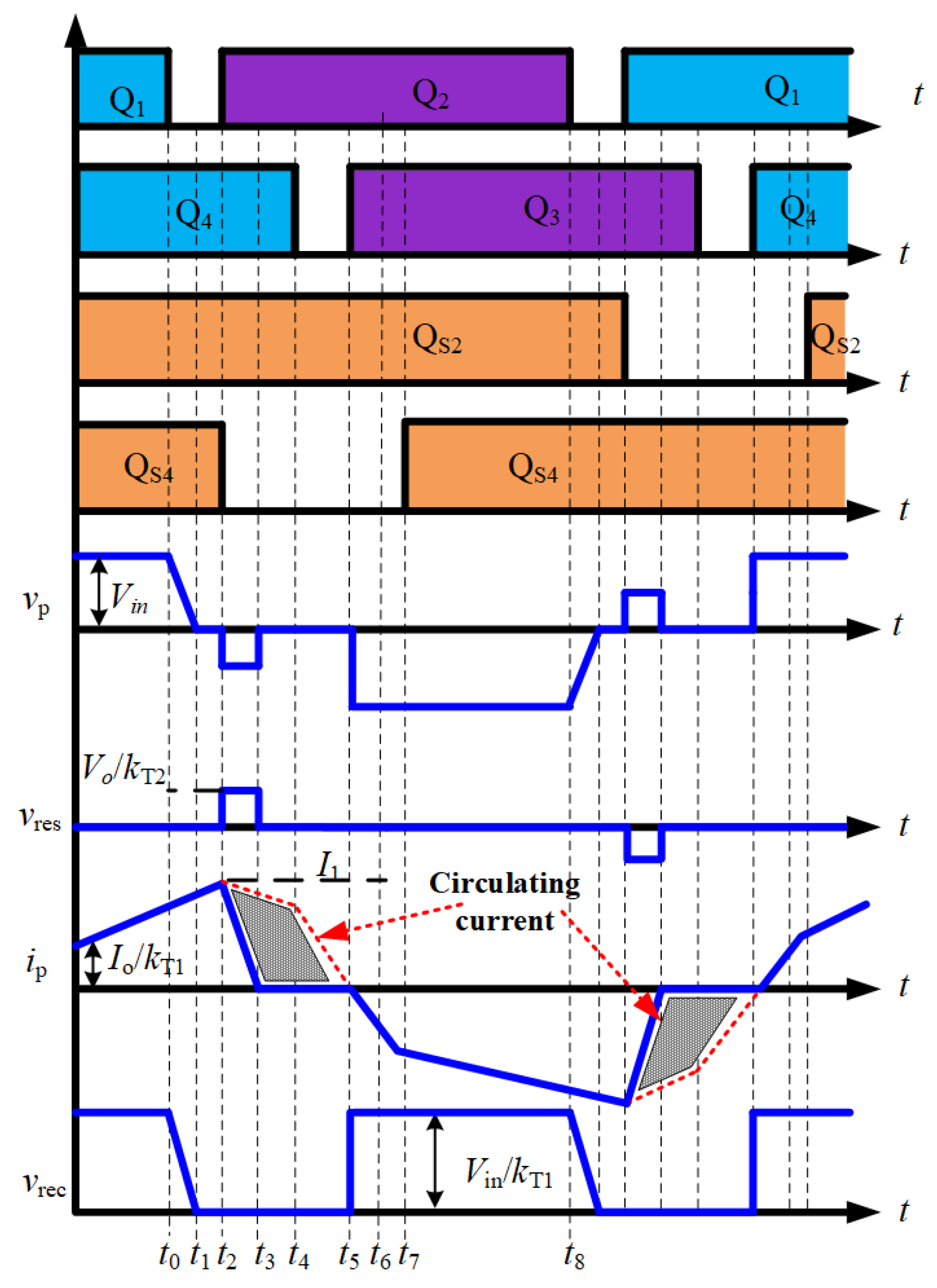
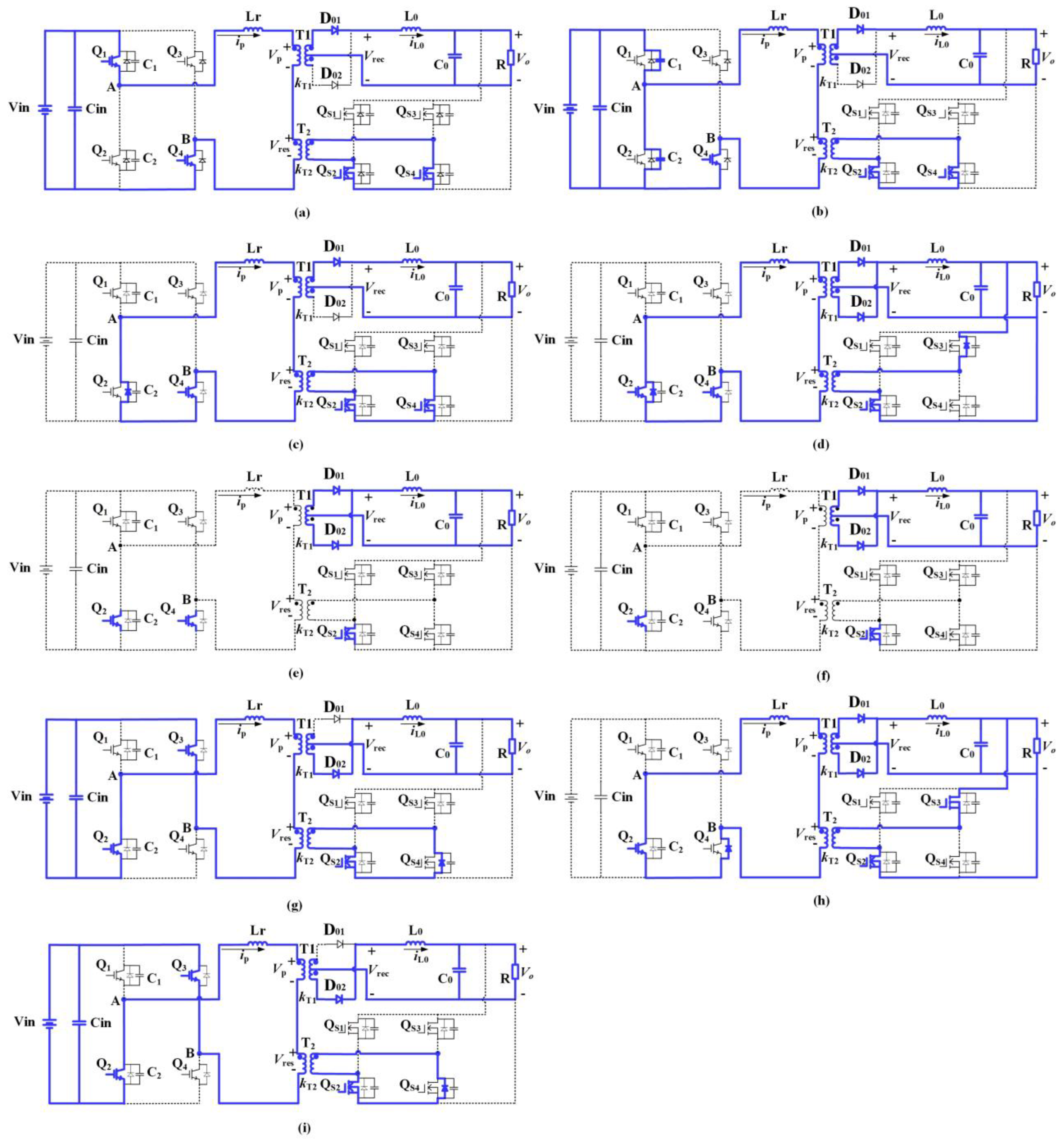
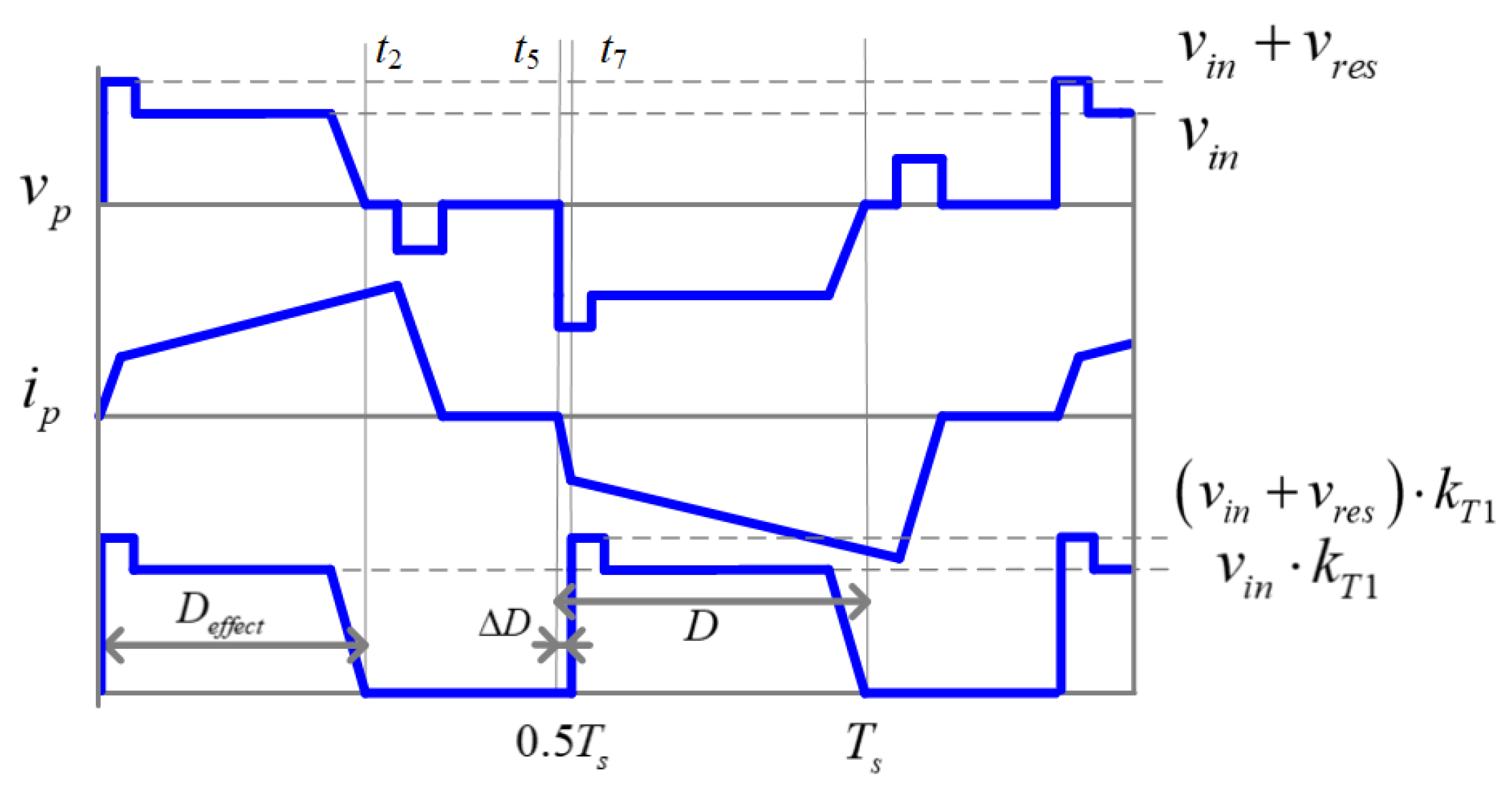


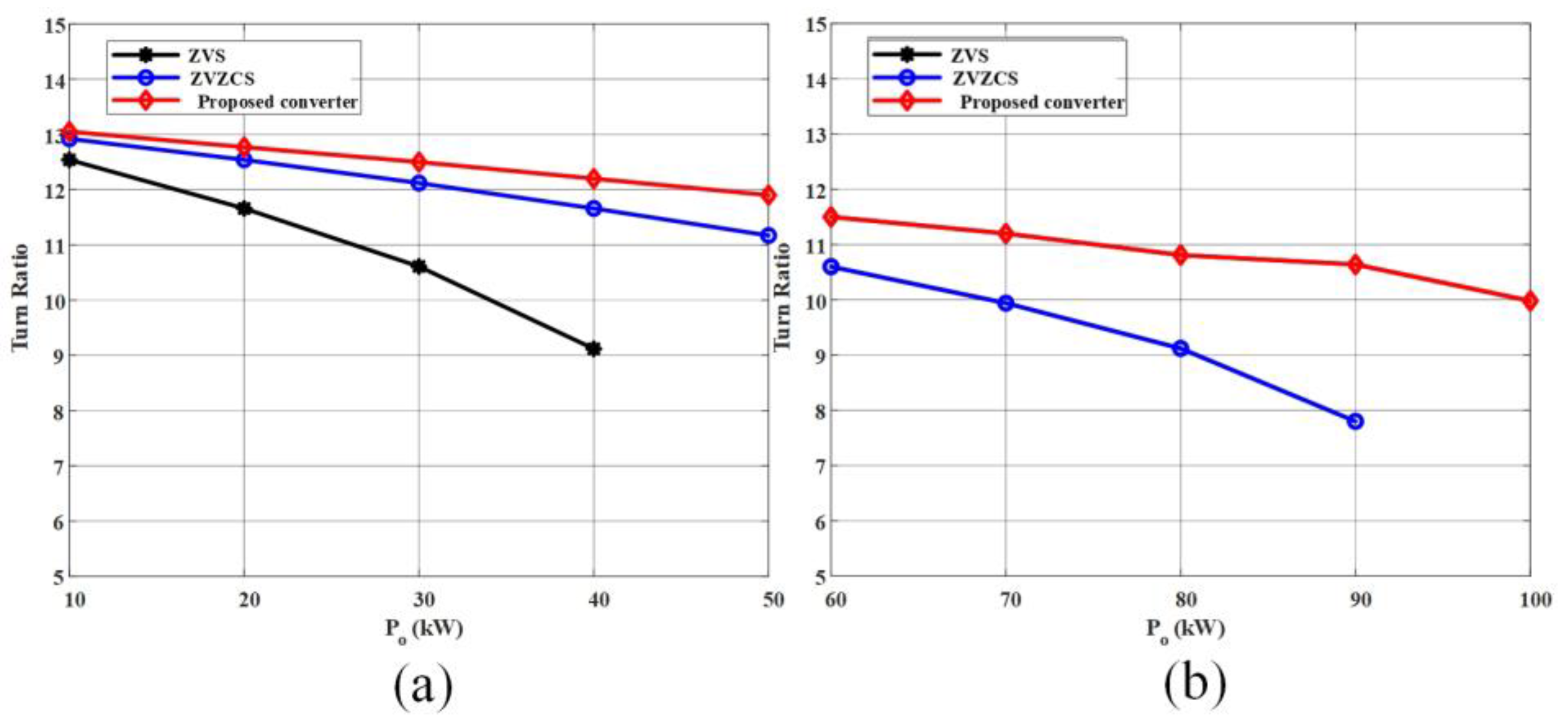
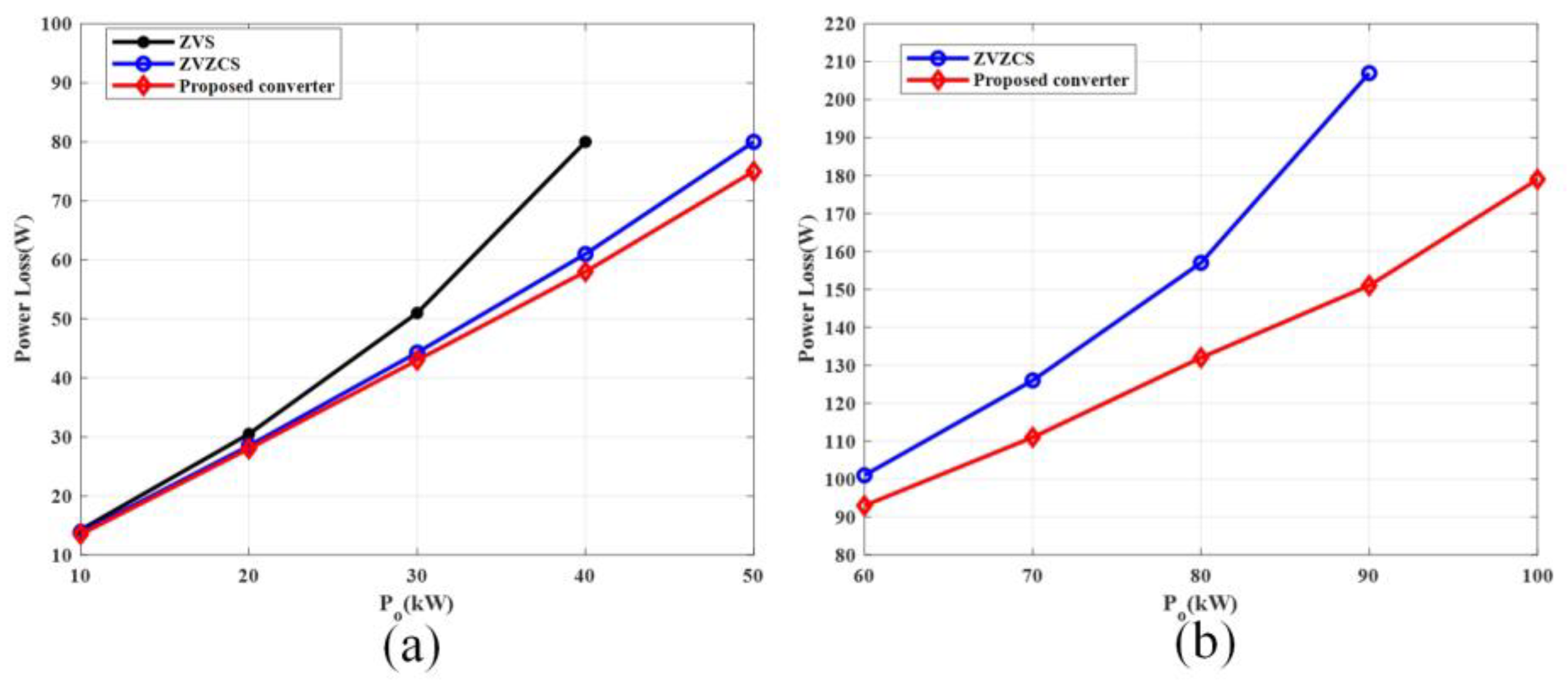
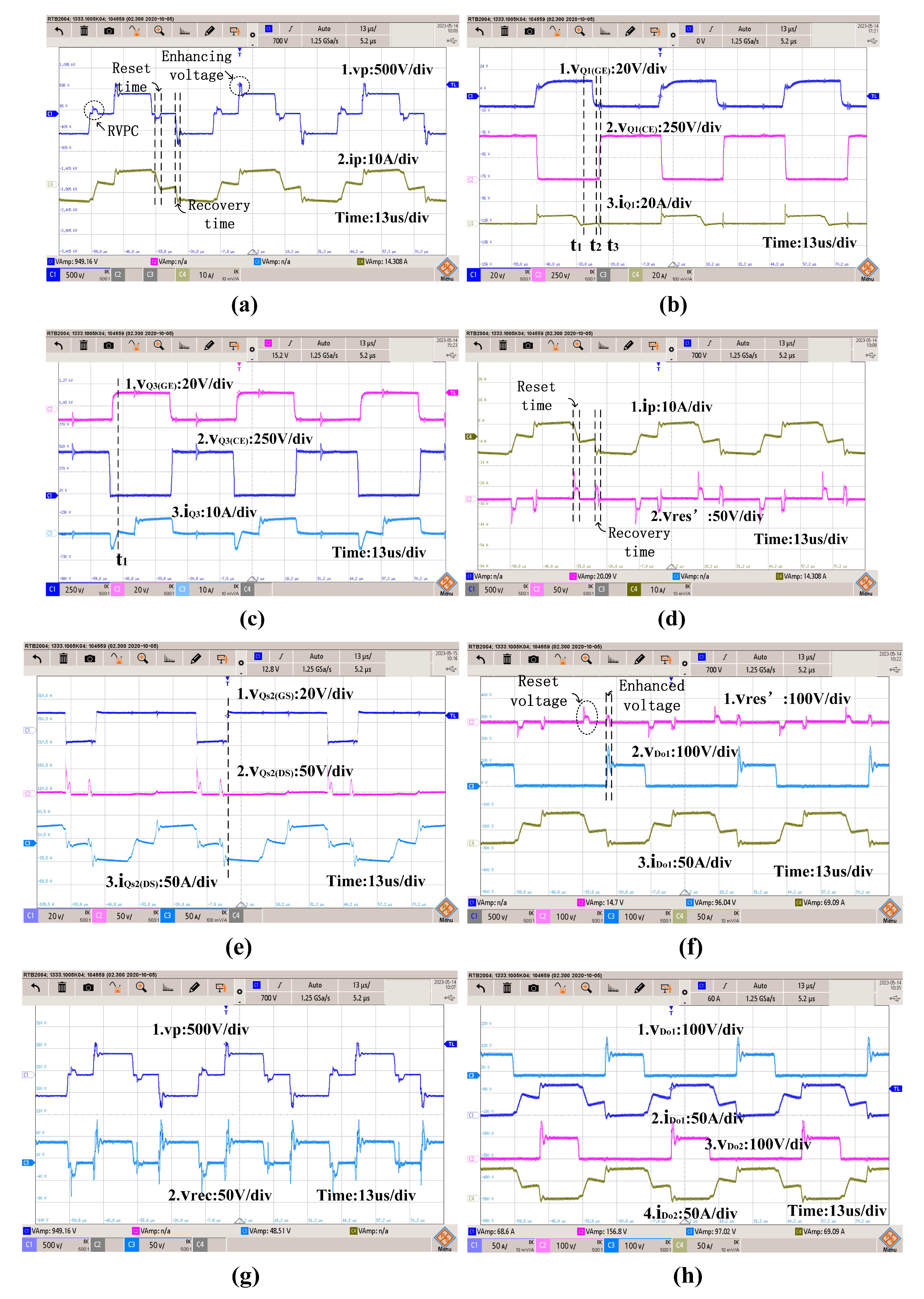
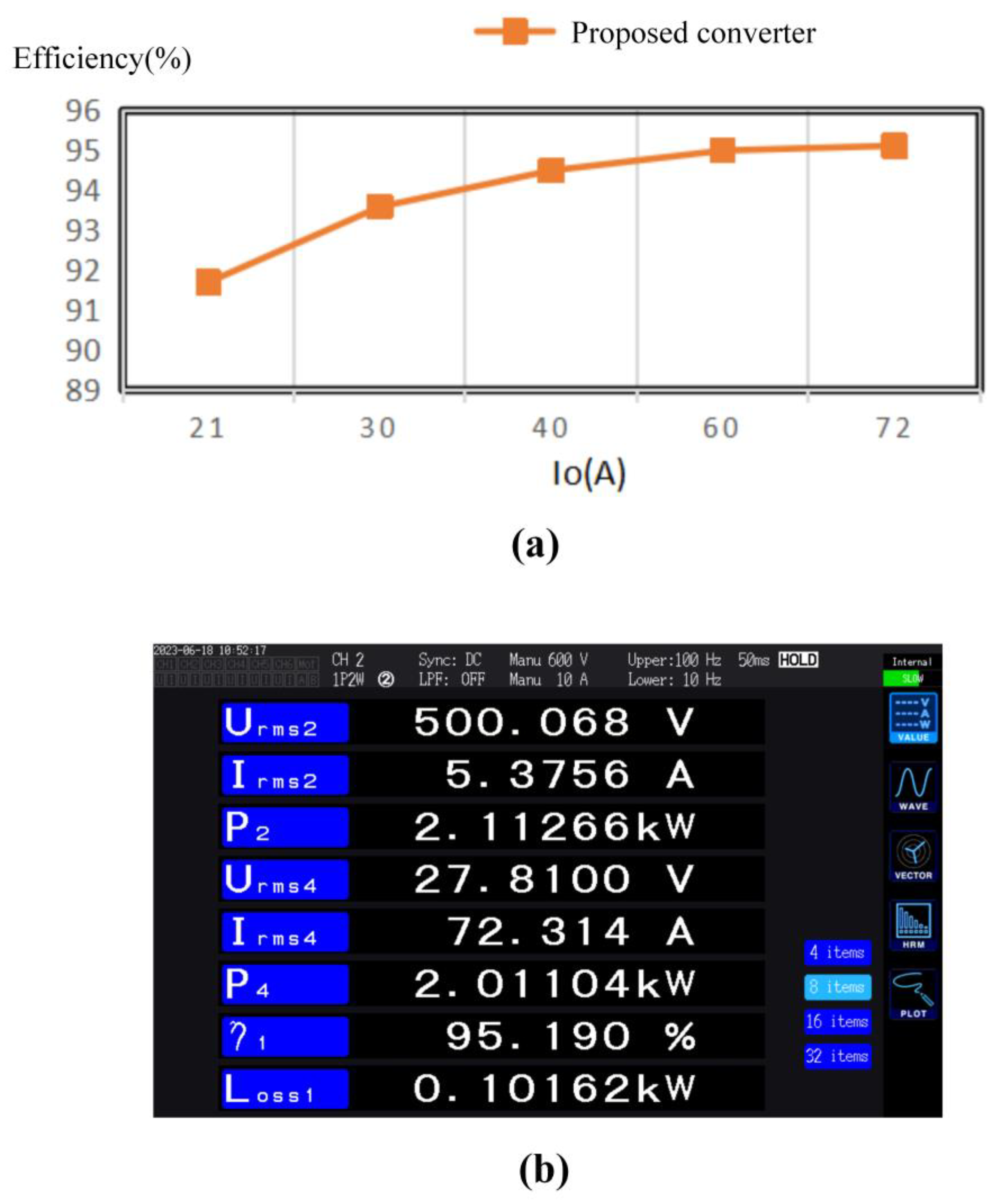

| Item | Figure 6a | Figure 6b | Proposed Circuit |
|---|---|---|---|
| Number of components | 11 | 12 | 13 |
| Conditions of soft-switching | Narrow range | Power rating limitation | Wide load range |
| Duty cycle loss (40 kW) | 0.3 | 0.12 | 0.08 |
| Conduction loss (40 kW) | 80 W | 60 W | 58 W |
| Item | Parameter |
|---|---|
| Rated power | 2 kW |
| Input | 400–600 V |
| Rated output | 28 V/72 A |
| Switching frequency | 20 kHz |
| IGBTs | FF450R12KT4 MMG150J120UZ6TN |
| kT1 | 10:1 |
| kT2 | 1:6 |
| Magnetic material | Ferrite |
| Volume of T1 | 506 cm3 |
| Volume of T2 | 356 cm3 |
| Turns of T1 | Primary: 20 Secondary: 2 |
| Turns of T2 | Primary: 13 Secondary: 78 |
| QS1, QS2, QS3, QS4 | IXFN110N60P3 |
| DO1, DO2 | MCK400TS60S |
| LO | 10 µH |
| CO | 2000 µF |
Disclaimer/Publisher’s Note: The statements, opinions and data contained in all publications are solely those of the individual author(s) and contributor(s) and not of MDPI and/or the editor(s). MDPI and/or the editor(s) disclaim responsibility for any injury to people or property resulting from any ideas, methods, instructions or products referred to in the content. |
© 2024 by the authors. Licensee MDPI, Basel, Switzerland. This article is an open access article distributed under the terms and conditions of the Creative Commons Attribution (CC BY) license (https://creativecommons.org/licenses/by/4.0/).
Share and Cite
Wang, Y.; Shi, Y.; Xu, K. A New Zero-Voltage Zero-Current Switching Converter with Minimum Duty Cycle Loss. Electronics 2024, 13, 518. https://doi.org/10.3390/electronics13030518
Wang Y, Shi Y, Xu K. A New Zero-Voltage Zero-Current Switching Converter with Minimum Duty Cycle Loss. Electronics. 2024; 13(3):518. https://doi.org/10.3390/electronics13030518
Chicago/Turabian StyleWang, Yuting, Yong Shi, and Kexin Xu. 2024. "A New Zero-Voltage Zero-Current Switching Converter with Minimum Duty Cycle Loss" Electronics 13, no. 3: 518. https://doi.org/10.3390/electronics13030518
APA StyleWang, Y., Shi, Y., & Xu, K. (2024). A New Zero-Voltage Zero-Current Switching Converter with Minimum Duty Cycle Loss. Electronics, 13(3), 518. https://doi.org/10.3390/electronics13030518







